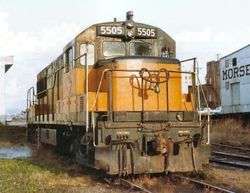| General Electric U28B |
|---|
 |
|
|
|
|
| Performance figures |
|---|
| Maximum speed |
70 mph (110 km/h) |
|---|
| Power output |
2,800 hp (2,100 kW) |
|---|
| Tractive effort |
70,000 lbf (310 kN) (starting) 64,000 lbf (280 kN) (continuous) |
|---|
|
The GE U28B diesel-electric locomotive model replaced the U25B in early 1966, featuring a slightly uprated prime mover (only 300 hp (220 kW) more power than the U25B). Early units had the same carbody styling as the U25B, while later units had design features (e.g., shortened nose) more in common with later models. After only a year of production, this model was superseded by the U30B.
Trains Magazine editor David P. Morgan wrote about General Electric's decision to go with 2800 horsepower in its 1966 locomotive production. The short article Morgan wrote in the November 1965 issue had line drawings of the proposed short nose U28B.
References
- Marre, Louis A. (1995). Diesel Locomotives: The First 50 Years: A Guide to Diesels Built Before 1972. Railroad Reference Series. Waukesha, Wisconsin: Kalmbach Publishing. ISBN 978-0-89024-258-2.
"GE's reaction to the competition: too mild or just right". by David P. Morgan from Trains magazine November 1965 page 14.
